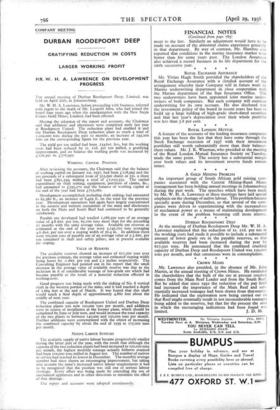COMPANY MEETING
DURBAN ROODEPOORT DEEP
MR. W. H. A. LAWRENCE ON DEVELOPMENT PROGRESS
THE annual meeting of Durban Roodepoort Deep, Limited, was held on April 20th, in Johannesburg.
Mr. W. H. A. Lawrence, before proceeding with business, referred with regret to the death of Mr. Leopold Albu, who had joined the board four years ago when the amalgamation with the New Steyn Estates Gold Mines, Limited, had been effected.
Moving the adoption of the report and accounts, the Chairman said that additions and alterations were completed early last year at Roodepoort United. The reduction plant had enabled it and the Durban Roodepoort Deep reduction plant to crush a total of 1,209,000 tons during the past 12 months, an increase of 243,200 tons on the corresponding figure for the previous year.
The yield per ton milled had been a34dwt. less, but the working costs had been reduced by is. lid. per ton milled, a gratifying improvement, and on balance the working profit was increased by £126,392 to £376,950.
WORKING CAPITAL POSITION
After reviewing the accounts, the Chairman said that the balance of working capital on January 1st, 1937, had been £118,993 and the net proceeds of a subsequent issue of 325,000 shares at 55s. a share had been £891,339, making a total of £1,010,332. The capital expenditure on shaft sinking, equipment, purchase of claims, &c., had amounted to £295,272 and the balance of working capital at the end of the year had been £715,060.
Development accomplished, including shaft sinking, had amounted to 63,380 ft., an increase of 8,429 ft. on the total for the previous year. Development operations had again been largely concentrated in the eastern and western extremities of the mine and disclosures on both the Main and South Reef had continued to be generally satisfactory.
Payable ore developed had totalled 1,286,500 tons of an average value of 4.8 dwt. per ton, 65,100 tons more than for the preceding 12 months with the same average value. Available ore reserves as estimated at the end of the year were 5,145,700 tons averaging 4.6 dwt. per ton over a stoping width of 50.4 in. In addition there were 721,000 tons of payable ore of an average value of 5.3 dwt. per ton contained in shaft and safety pillars, not at present available for stoping.
VALUE OF RESERVES
The available reserves showed an increase of 617,500 tons over the previous estimate, the average value and estimated stoping width being lower by a dwt. per ton and 2.2 inches respectively. The Consulting Engineer had pointed out in his report that the small decrease in the average value of available reserve was due to the inclusion in it of considerable tonnage of low-grade ore which had become payable as the result of a material reduction effected in working costs.
Good progress was being made with the sinking of No. 6 vertical shaft in the western portion of the mine, and it had reached a depth of 1,664 feet at the end of March. It was hoped that this shaft would reach a final depth of approximately 4,860 feet about the middle of next year.
The combined capacity of Roodepoort United and Durban Deep reduction plants was now 120,000 tons per month, and additions were in course of installation at the former plant, which should be completed by June or July next, and would increase the total capacity of the two plants to between 140,000 and z5o,000 tons per month. Further additions were contemplated with the object of increasing the combined capacity by about the end of 1939 to 175,000 tons per month.
NATIVE LABOUR SUPPLIES
The available supply of native labour became progressively smaller during the latter part of the year, with the result that although the capacity of the two reduction plants had been increased to 120,000 tons per month, the highest monthly tonnage actually hitherto attained had been z zo,000 tons milled in August last. The number of natives in service had reached its lowest in December. The monthly average number had since shown an encouraging improvement, but taking into account the mine's increased native labour requirements it had to be recognised that the position was still one of serious labour shortage. Every effort was being made by extending the use of mechanical appliances and in other directions to minimize the effect of that shortage.
The report and accounts were adopted unanimously.


























































 Previous page
Previous page